6 ways to get a job significantly faster

 James Nguyen
James NguyenHave you spent months trying to get a job without success? I know, I’ve been there.
Having been through the process of building up my company, hiring people throughout my years of running my business. Then, becoming an entrepreneur, recruiting for other businesses to build my next venture - Spare Staff, I’ll share with you 6 ways that will help you get a job significantly faster.
But before we dive in, you should clearly define your goals:
- Are you running out of cash soon: in this case, you may just want any job as soon as possible. Quick income is your goal.
- Are you looking to enhance your career, or gaining more experience (eg students looking for jobs)? In this case, getting the right job is what matters. Taking some time to learn the right skills may slow you down in getting a job in the short term, but will speed up your career later on. If you’re not stressed about your finance, this approach will serve you well.
Now let’s look at how you’ll get a job
1 - Do a Walk-in Interview
Everywhere you read, many are saying it’s hard to get a job interview. There are tips, advices on how you can improve your chances of getting a job interview.
How about doing a walk-in interview?

What is a Walk-in interview? It means you can just walk-in, the on duty-manager will interview you on the spot. You don’t need to arrange appointments, just come in.
I’ve asked many employers about walk-in interviews, many said Yes. “Yes, face to face discussion is better”. “Yes they can come in anytime between” this time and this time. “I’m here every day, they can come in anytime”.
You’ve heard it right. Not every business owner, manager wants to go online to read resumes, or have the time to. They are not always in front of their computers to review resumes. A face to face discussion tells so much more about a person than a text-only resume. Many hiring managers will prefer meeting you in person.
Sure, there is a chance that you’ll waste your time doing a walk-in interview but still won’t get the job. But isn’t it already the case with regular job interviews? A regular job interview will still take a large chunk of your time, and by no means guaranteeing that you’ll get the job. You’ll have to turn up at a time chosen by the hiring manager, you may not get the job still.
A walk-in interview means you’ll get to choose when to come in at your convenience. If you’re unsure, you can call the employer office in advance to double check. If they are open to take walk-in interviews, there is a good chance that they will do it. Often the employer leaves their direct contacts on their ad. Otherwise, every company has a website, a phone number, an email for you to look up. Just google them.
What if there are lots of other candidates who will do walk-in interviews? There aren’t many.
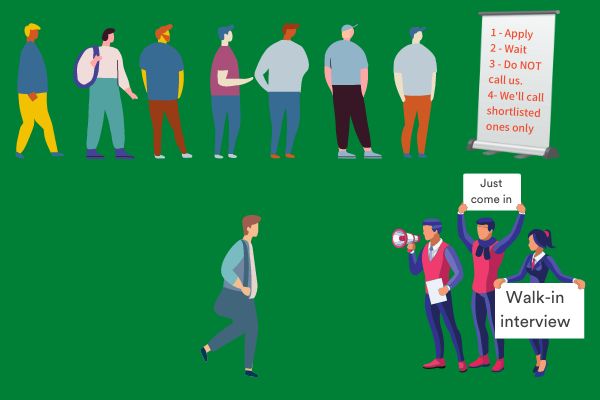
The pandemic has caused a shortage of workers across many industries. Businesses are struggling to keep their staff. Only the most motivated candidates will do walk-in interviews. These are ones who have thought really hard about it, did background checks on the employer, checked the distance, tossing around their options before they lean in.
Candidates who doubt that they are not qualified for the job will not come in for walk-in interviews. They have already selected themselves out. Ones who decide to come in, are ones who truly believe that they have the best chance.
By no means that you will get hired if you do walk-in interviews. But you will compete with a much smaller number of candidates only. It is still up to how you communicate, prepare for the interview to land that job.
Don’t give up on applying for jobs online though. Keep your options and apply for jobs as normal, but find a job that will take walk-in interviews and try it.
Our job site lists all jobs that accept walk-in interviews near you so you can give it a shot. They range from hospitality jobs such as cafe, restaurant, hotel jobs to sales, marketing, trades, labourers, IT jobs.
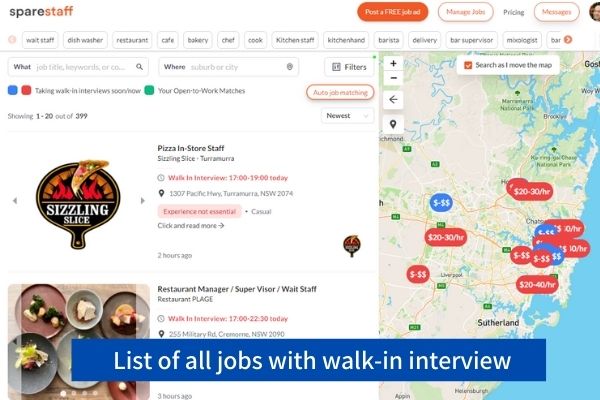
In my own experience, I have hired employees through both the traditional interview process, and through walk-in interviews. I must say, the walk-in interview candidates were by far the best. I’m not joking, by far! I regretted not hiring one who did a walk-in interview.
Let me be clear, the role I was hiring was not unskilled roles. The first role was a full stack (MERN stack) web developer, and the second one was Sales and Marketing intern. Each job post attracted 50 - 80+ candidates, many were within 10 minutes from my office. Guess how many turned up for walk-in interviews? 2 for each job! Two!
The two who turned up, were truly passionate about the job. They wanted it the most. They looked up our company, read about us, read about what we were doing. They thought hard about it and decided that they wanted to be part of our company. Thus, they asked for it. The other candidates had already selected themselves out, hence we never heard from them.
To be honest, the two candidates did not have the best resume. They did not possess the best skills, and experience for the role, and they knew it. But they believed they would try their best and they would make it. They did, and I was not disappointed. Their attitude was excellent.
As a hiring manager, your job is to sort through a long list of candidates to find a few qualified ones. Why not let candidates self-select themselves in, or out? You’ll end up with a much smaller pool of highly motivated candidates to select from.
When posting a job on our job board, you have the option to enable Walk-in interviews. Simply set days and time that you know for sure you’re available for walk-in interviews for job seekers to see. After you’ve filled the role, simply turn it off. Try it, you’ll be surprised how well it’ll work in your favor.
2 - Use Open-to-Work, Auto job matching
If you’re selling a product, you need to tell people that you’re selling it. It’s no good if you open a shop in a quiet street after all. Similarly, if you’re looking for a job, let people know that you’re open to work, so that prospective employers will find you.
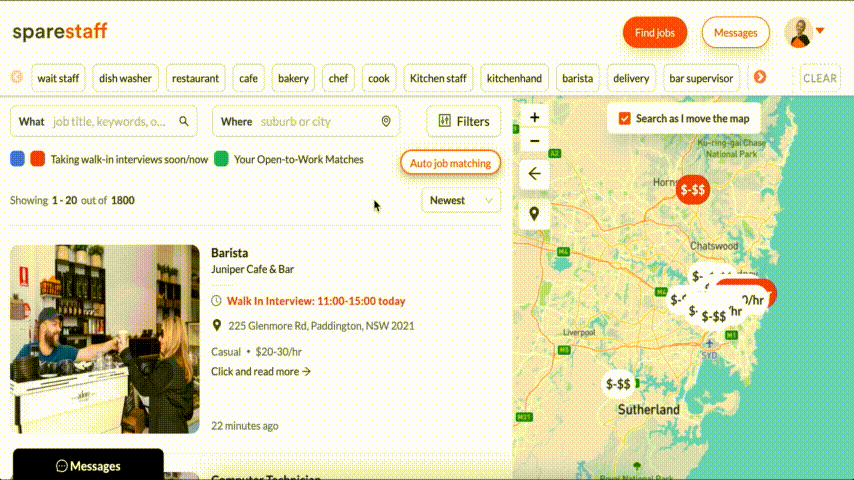
I’m not reinventing the wheel here. Open-to-Work isn’t new. LinkedIn and many other job sites have this feature. You’ll often see this label on LinkedIn. It’s a great way to let employers know so they can approach you.
In fact, most job sites, including ours, will let you specify that you are open to work. Companies can reach out to job seekers who are open to work. When you enable this feature in your profile, you may get a job offer out of nowhere. In the end, it’s always good to decline a job offer rather than having to look for one and get rejected.
Here’s an important tip: check your email regularly, set it up on your phone. Your personal phone number is not disclosed to recruiters. They will reach out to you via emails.
Job sites let employers do a search for job seekers who have enabled Open-to-work. LinkedIn sells Recruiter Lite and Pro products that let recruiters search for Open-to-work candidates. Employers can also search within their social networks to find Open-to-work professionals.
More than that, our job board also lets you configure your job preferences such as automatically showing your resume to jobs that match your requirements based on location, wage, job type (eg Full time), and classification (eg Marketing).
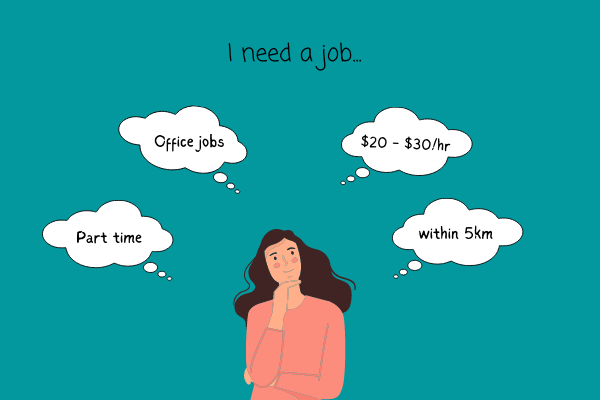
The fact is, you can’t hunt for jobs 24/7. And while you’re not looking, recruiters might be. Setting your profile up with open-to-work helps recruiters find you at the right time. Imagine waking up with a job offer in your inbox, your whole year living expenses paid! Your job hunting shouldn’t be a one-way journey. Give it a try.

Often, job seekers may not know what they’re looking for. There could be jobs out there that are close to you, suitable for you, with good pay and you don’t know it. The job title may not be what you’d type into a search box when you search for jobs. Recruiters, on the other hand, know better who they’re after. The only thing left to do is for you to tell them that you’re available for work.
And have I not mentioned it? It’s Free. That’s right, it costs you - job seekers, nothing to activate open-to-work. Employers may have to pay a fee to find job seekers, but not you - the job seeker.
3 - Look for jobs that you have experience in, or no-experience job if you’re new to workforce
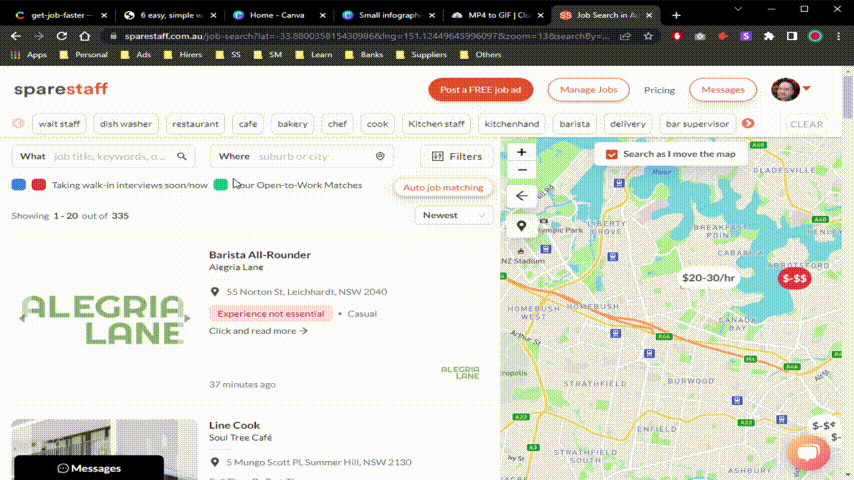
This is particularly true when your savings is running low and you need any job as soon as possible. If the job ad reads certain experience is required, and you have never done the same job before, don’t waste your time applying for it.
And, let’s be very clear about the experience requirements: say the job is “Medical receptionist” and the employer requires experienced candidates, though you have done office administration work previously, but you’ve never been a medical receptionist, then you do not have “medical receptionist” experience.
A medical receptionist is required to know some medical terms, familiar with booking systems that medical centers often use. Since you’ve never worked as a medical receptionist, chances are you will not be in the priority list.
What about jobs that say “experience is preferred but not essential”? You can assume that experienced candidates will be the employer’s preferred choice first, only when they have exhausted all options for experienced ones, then they will start considering inexperienced applicants. If you have no experience, it’s likely that you will be lower in the hiring list.
If a job ad reads, “no experience is required”, by all means you should go for it.
The first to apply have some advantages, but not always. Keep in mind that a role may go vacant for weeks before it’s filled so don’t get discouraged if you’re not the first applicant. However, with the shortage of workers caused by COVID, first applicants will get called for interviews fairly quickly. In hospitality, many employers may call the first suitable candidates within hours. The good news is that they have lots of vacant shifts, hence, it’s more likely that you will still have a chance even if you apply late.
Once you’ve worked out a list of jobs that suit you, it’s best to look for jobs closer to you and suit your availability. Aim for 20km or less distance. 30km or more is generally getting a little too far. Even if you think the distance is not a problem for you, hiring managers know well enough from experience that the distance will eventually become a problem for you later on which may lead to you leaving the company.
4 - Work for a startup or take an internship job
If you’re looking to kickstart your career, gain new knowledge, not just an immediate income stream, working for a startup or as an intern is a great option.
You won’t make a good living by working for a startup or doing an internship, but the learning curve is significant, especially working for a startup.
Startup companies are less organized and often “chaotic”. You’ll hear that by working for a startup, “you will wear many hats”. There is a wide range of tasks for you to take on. This is a good thing because you’ll learn to do many things on your own.
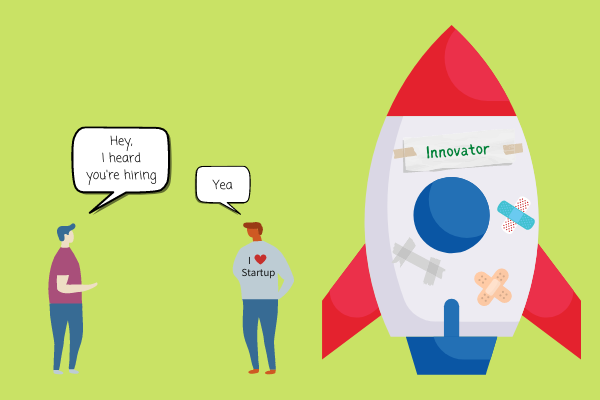
By working for a startup, you’ll get to do many tasks that you are highly unqualified for. This may range from administrative work to marketing, doing sales to business clients. There are so many unfilled positions at a startup that you can roll up your sleeves and try to tackle it.
This is beneficial if you’re kickstarting your career and want to learn different skill sets to see what you like the most. By exploring a variety of work, you might find out that you have a passion for, say sales or marketing.
Working for a startup also has a lower barrier to entry. Generally startups cannot afford to pay for highly experienced person. They are willing to take on a less-experienced candidate to start with. You’ll get the chance to work directly with the founder of the business and watch how a business is built up from scratch.

Though, in a startup, you are expected to be more independent and work unsupervised very quickly. You won't receive months of training. You're expected to do real serious work literally the next day.
Patrick Collison, the founder of Stripe, said his startup’s first hires were mainly young talented people who were undervalued, and his startup was “push people off the cliff” type.
Another advantage of working for a startup is that you'll get a chance to make an impact.
Your opinions matter and you have the chance to make things happen such as delivering new product features to users, or implementing a new sales marketing strategy.
This is contradictory to working in a well established firm where you’re expected to follow fixed procedures; your ideas must get approval from your manager, your manager’s manager, and so on. You must get all Yes from upper management to implement a change.
If working for a startup does not fancy you, taking an internship at an established company is an alternative. An internship will help you learn some of the first skills in your chosen career such as accounting, or marketing.
This option is helpful if you already know that you want to build a career in a specific industry, say marketing. Your marketing internship will cover mostly marketing tasks such as content creation, search engine optimization, or search engine marketing. In this case, an internship will be particularly helpful because you’ll learn from experienced professionals who have done it before.
Either way, working for a startup, or taking an internship, will help you make the first step in your career and the experience is tremendously helpful in finding your next job. The pay isn’t great. As long as you’re not in a desperate financial situation, you can compromise on the earning in the short term to achieve a much bigger goal in the long run.
On another note, if you’re planning to build a career in, say marketing, and throughout your university years, you should at least get one (preferably more) marketing-related job or internship, or do some side projects that require marketing. Otherwise, your resume will look bad.
Hiring managers will wonder what you’ve been doing in those years that somehow you did not manage to land at least one job that is related to your major. I recommend you to at least get one, or (better) more jobs that is related to what you study, even if it means compromising your short term income.
5 - Create a resume that is readable by both human and computer
How did you find a website on the internet? First, you started by typing in a search in Google or another search engine. Then, you were taken to the website. For the website to be seen by you, its content must first be read by Google’s computer bot. The website owner had to create, optimize content so that it’s readable by computer bots, before it’s read by you, a human.
Similarly, a lot of resumes will need to be read by a computer bot first, also known as an Application Tracking System (ATS), before it’s passed to a human - the hiring managers. Technology is taking over the world. Software is dominating in every industry. Not all companies are using ATS yet, but it’s getting very popular. It’s safe to assume that after you’ve submitted your resume, at the other end, it’s not an 80-year-old lady who would print it out and read it.
Your resume will need to be processed by a computer first before it reaches the hiring manager. There is a problem with this though. These ATS are nowhere as good as Google at reading text from your resume. And, your resume might not even be readable by ATS.
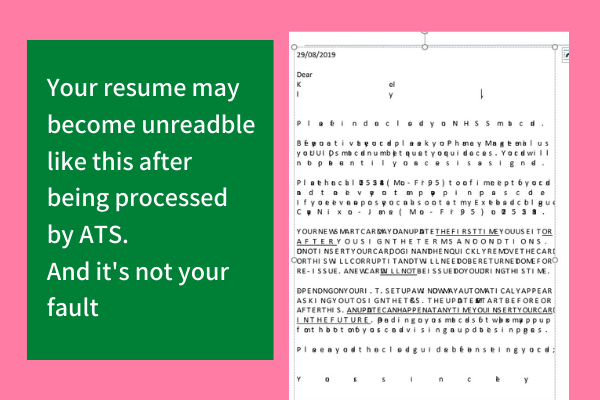
The good news is that, to overcome this problem, it’s actually quite simple. The key is to keep your resume simple: in Word or PDF document, using standard international fonts, with no columns. You can have an image such as your profile photo. The image won’t be readable to ATS hence it will be skipped, but it will be seen by the hiring manager after it’s been processed by ATS.
There are many resume templates on the internet, but you don’t know if the resume was created by someone who was aware of ATS, or if it’s readable by ATS. The resume may look fantastic, and creative, but it means nothing if it doesn’t get past an ATS. Its fonts might be a foreign font that becomes scrambled when ATS tries to read it.
To fix this, simply open Microsoft Word, or Apple Pages app, create a new document, and start typing your resume! That’s it. Sounds simple enough, and it is. It should take you an hour or less to complete your resume. You can add a profile picture into it.
A link to your social profile would be good too. It is the norm now that hiring managers look into candidates’ social media profiles to understand who they’re interviewing. Why not just give it to them and make it easier. Aren’t we already sharing photos on social media?
Before you start writing a 2 page-long resume, consider this: its first paragraph needs to catch the attention of the reader. I recommend you to write one paragraph as a summary about you, like a quick introduction, and make it count. Once the hiring manager is impressed with the opening of your resume, he/she will read the rest.
Throughout your resume, use bullet points to make it easy to read. Mention all the names of tools that you have used or are familiar with, skills and experience that you have, for example: Google Doc, Google Sheet, Facebook Ads, Google Ads, HubSpot CRM etc. These keywords will be picked up by ATS which will then rate your resume more relevant to the job being advertised.
Considering that you will re-use your resume for every job that you will apply for in the future, a good one or two hours of effort to write a simple, good resume goes a long way.
6 - Do side projects
This one may sound counter-intuitive, because it takes you time to do side projects and you won’t get a job faster now. In the long run though, it will help you get your next jobs faster. What’s more, not just any job, the right job, the one that you really want! Thus, even though it slows you down from getting a job in the short term, it will speed up your career. I suggest that you try this and put in a great effort for it.
Generally, it goes like this, you attend schools, universities, do assignments, thesis, exams etc. You get some odd jobs in between. Then, you graduate and look for the right job. The problem is, most of your friends, classmates are doing the same, following the same path. Your grades aren’t going to make you stand out.
When you’re young, you haven’t got a family and kids, you have more time. Spend this time doing some side projects that interest you. Ask your friends to join you if possible. Having some peers doing side projects is extremely useful to experiment working in a team, collaborating in a project. You will learn a great deal about your peers, and gain practical skills.
Just ask some of your friends to join you. Some will reject the idea, some will be excited to try. I suggest that you ask friends who have different backgrounds, different domains of expertise, and different personalities. Say, you have knowledge in marketing, then ask friends whose major is IT, and business to join you.
If, somehow, you cannot find any friends to join you, don’t get discouraged. Try to do a project on your own. Try to figure it all out by yourself. You’ll still learn a great deal. Down the track, you can show your progress to your friends, they may get excited at that time and join you.
What projects should you do? There should be plenty that you can look up on the internet that are related to the field of your study or your interests. Some online research should give you some ideas. If you can’t even find anything, then I’ll give you this challenge:
- Start a project where you need to find 20-100 products, and sell these products to 100 customers and make a revenue of $1,000 or more.
- Your budget to start is anywhere from $200 to $600, which means your profit will be $400 - $800.
- You don’t need to carry inventory of the products, you can choose to but you don’t need to.
- Your first 10 customers can be friends or family, but the rest must be complete strangers.
- You are not allowed to sell off existing marketplace such as eBay, or Facebook marketplace. Though, you can leverage traffic from these platforms to lure customers from their site to yours and they will pay you directly, without going through eBay or Facebook.
- That’s it.
Sounds easy enough? It’s harder than you think. You’ll first need to do research to think of what products you’d sell. Perhaps you’ll need to learn to build a website on a low budget. You’ll then enter the products to your website. This is the easiest part.
Getting people to pay you for the products is a much harder task. Your circle of friends and family can help you get started and give you some feedback. Then, the real challenge is to get complete strangers to take out their wallet to pay you. These people don’t know you and if you’re willing to give you their hard-earned money and you earn a profit, then congratulations, you’ve done a great job. You may even find yourself a real business after this.
You will spend a significant amount of time doing this, but you’ll learn a lot. Through this experience, you’ll learn a wide range of skills that will help you get the next job, the ideal job that you’d love to get. You’ll learn computer skills, web design, some IT skills, administration; you’ll use tech tools that you may never use before, customer service, sales and marketing skills, after-sales customer support etc.
All of these are extremely beneficial to show off in your resume, in an interview and help you get a head start on your career.
Conclusion
When you’re looking to get a job faster, decide for yourself if your goal is:
- A quick income right now because your savings is running low, or
- Getting the right job: Your finance allows, take some time and learn the right skills now, it will help advance your career and get the right job significantly faster in the long term.
Here is 6 ways you get a job faster (depending on your goal):
1 - Do a Walk-in interview: what's a faster way to get a job interview than taking a walk-in interview? You just walk-in and you get an interview. Prior appointment is not required. Many employers are already taking walk-in interviews. Retail, hospitality, sales and marketing, IT … you name it, many hiring managers prefer this. Find a full list of walk-in interview jobs here and just go there already.
2 - Use Open-to-work, Auto job matching: many job sites have this feature, including LinkedIn and our job board. It’s Free and easy for job seekers to use. Prospective employers will know that you are available for work and they will reach out to you for job offers. You may wake up tomorrow with a job offer in your inbox. Tips: check your email regularly, because recruiters will reach out to you via emails.
3 - Look for jobs that you have experience in, or no-experience jobs if you’re new to workforce: be clear about your experience. If you haven’t worked as a “Medical Receptionist” previously, then you don’t have medical receptionist experience, don’t waste your time applying for this job. If you’re new to workforce, find jobs that say no experience required. Ideally within 10km distance from your home. This helps if you’re looking for quick income.
4 - Work for a startup or take an internship: working for a startup or taking an internship has a lower entry barrier. You don’t need to have lots of experience to be qualified for. By working for a startup, you’ll wear many hats and learn a wide range of skills. Taking an internship helps you learn specific skills that you need for your selected career. This is useful if your goal is to get the right job faster, not a quick income right now.
5 - Create a resume that is readable by both human and computer: before your resume reaches a human, it will need to pass an Application Tracking System (ATS) first. ATS is a computer program that reads text from your resume and rates how relevant it is to the job you are applying for. Simply use Microsoft Word, or Apple Pages, or Google Doc to write a resume with a simple format, using standard fonts, no columns and your resume will be readable by ATS, increasing your chances of getting the job.
6 - Do side projects: this will not help you get a job any time soon in the short term, but counter-intuitively, it will help you get the right job, the job that you’ve always wanted, much faster in the long term. It’s best to do projects with a group of friends who have different sets of skills. Or, you can do a project by yourself. Find a project that interests you, or the challenge that I give above.
More posts
Are you looking for jobs?
Find your matched jobs on Australia’s best Free job site (including jobs with Walk-in interview)
Find jobsAre you an employer?
Post a job ad and start getting matched applications (no credit card required)
Post a JobAbout Spare Staff
Spare Staff is Australia’s job site, with much more.
As a job seeker, you can search and apply for jobs that match with your requirements, including jobs that take Walk-in interview. 100% Free.
As an employer, you can post Free job ads and find matched candidates based on location, skills, availability, wage expectation (plus profile photo) at the click of a mouse.
Are you looking for jobs?
Find your matched jobs on Australia’s best Free job site (including jobs with Walk-in interview)
Find jobsAre you an employer?
Post a job and start getting matched applications (no credit card required)
Post a Job